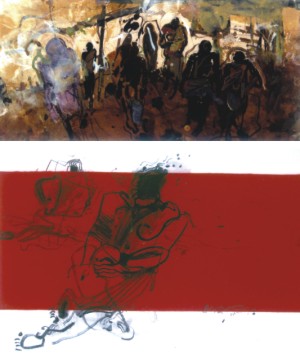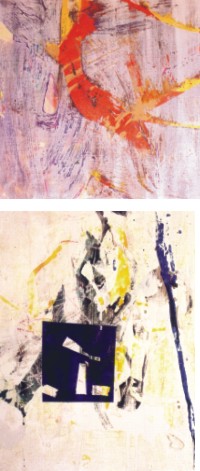Art
Blending Pathos
with Passion
Fayza Haq
Dreams and desires comprise Anokul Mojumder's theme in his third solo exhibit, starting at Shilpangan, Dhanmandi, around mid March. Bicycling through the rain, hail and afternoon heat one has seen him whizzing to and fro from Shilpangan, an art gallery where the 39-year-old painter is often found holding the fort. The gallery buzzes with visitors throughout the year. Anokul not an artist to be overwhelmed with pain and agony sings of ecstasy.
The elements of satisfaction, hope and fulfillment, expressed in soothing and buoyant earthy colours bring in incredibly happy dreams of the past. Despite the unabated suffering Bangladeshis have gone through, they go ahead with their planning for some respite for the future generation.
" I cannot envisage a day in my lifetime, when we will be free from foreign credit," says Anukul, gravely. Yet he smiles when he recalls the fun-filled days of his youth. This was celebrated with food, music, dancing, -- with the " Banglaar dhol" (large "Bangla" drums), cymbals, tongs, "do-taras" ( stringed instruments) and bells on the feet. Dancing, singing and rejoicing to the memories of the past, the people of Bangladesh go on with their life.
Hoping for a better day, taking each day as it comes, the joyous figures in Anokul's charcoal, acrylic and mixed media work, 50 in all demand attention. As an artist yet to step into his 40's, Anokul presents boldness and a capacity to dream. Though muted and subtle, his works sing loud and clear of a vision that does not despair at all times. It does not always dwell on suffering and agony of the past and present. His dreams and imagination lead him on to work incessantly, and depict rays of hope through the gathering clouds.
 |
| Song of the baul, mixed media on paper, 2009. |
Full of symbols, obvious human figures, inclusion of nature-- clouds, birds, flowers -- Anokul's works have progressed from Impressionistic work, to mingling and mixing figures with bright, contrasting fine lines; and onwards to careful but not stylised depiction of man and nature. The two vital subjects appear to be gliding, sliding, curling and twisting. They then progress on to the tune of buoyant rhythm --- despite whatever dooms is in the forecast.
In his last solo exhibition, held at "Shilpangan", Anokul dealt often with the position and role of women in society. "In all my exhibitions I try to focus on building up our society and its integral parts, like the mother and child theme, and the theme of overwhelming male domination -- which has crippled many societies especially in the east. ' Second Sex' questioned that, but its impact has not reached all of Asia till date. The fretted feet of the people in the Dhaka metropolis was also shown, crying out for preservation of our environment. Dirt, noise and various types of viruses and germs were, obviously, kept in mind, because they are demons in disguise, and often not seen at all. "Tales of Dreams in my solo of March presents the mixed images of my dreams -- both happy and unhappy, the skies and rivers of my youth, the nostalgia, on which my March exhibit is pegged. My human images are seen against nature, our only hope for the future. The human figures are let free into the skies, flat land and the innumerable rivers and rivulets."
 |
Top: Heart’s song, acrylic on paper, 2009. Bottom: Love takes wings, charcoal on paper, 2009. |
The festivities, that Anokul often dwells on in his March exhibit, are seen within a cultural net of treasure troves. "Kirtan", "Baul " songs, and other songs of devotion, seasons-- like that of " Pahela Baishakh". Other songs that drive away diseases, as is believed in Bangladeshi villages, are included. Hence we get the songs of love and devotion, and songs that invite inspiration of our elders and protective spirits, of the air, land and water. This is what the poets and musicians of Bengal have dwelt on -- over the centuries -- defying the shackles of the British Raj and "Pakistani" rule. Originating from Bagerhaat, Khulna, and inspired by SM Sultan, in particular, Anukul's human figures have rippling muscles and long, lissome limbs -- as they stride and dance without fear. Since the subjects are figures from imagination, they are empowered with strong, determined features, inspired by, modern artists like SM Sultan; and the ancient caves of Ajanta and Elora.
The works are in shades of browns, reds, and other earthy colours; plus variations of pearly whites, jade, aquamarine and lapis lazuli. At times the vermilion turns to ruby red to highlight or even offset the subjects. These are carefully outlined with jet-black so that the figures, and other surrounding motifs from nature, and suggested sections of the human body, are depicted with care and delightful delicacy. In his romantic and idyllic creations of embracing couples, seen from various angles --- the cupid lips, gazelle eyes, aquiline noses and curving necks --- the profiles seen from numerous points --- are bewitching, to say the least. Anokul has certainly not wasted his years as an artist. His vision encompasses the visual art world of " Bangla", as Milton put it in his "Paradise Lost ".
The celebration of life is uppermost in the artist's mind. ; The "Banglar Dhol " is shown being played in the sky, in between the sky and the earth, and what appears to be even in the rivers: Such is the effect of the bouncing, cascading, luminous colours. Charcoal is used on paper in most of Anukol's works in this exhibit. No wash is used for the backdrop. Once more, details of human figures are included in the backdrop to lend interest; and to add to the theme of musicians in the countryside. Footprints in different shades and details similarly galvanize to the depth of the delineation.
Yellowish brown and other soft and sophisticated tints appear to swim, oscillate, shake, shiver and fly before one's ideas --- to usher in dreams, hopes and desires of the past, present and future. Poignancy is the end product of the artwork of this driven artist. Anokul is desperate to present the world of both "agony and ecstasy." Subtle and symbolic, the message goes home with an unforgettable impact.
For whom the Heart Throbs ...
 |
Top: Good Afternoon!, mixed media on acrylic paper. Bottom: Door to no where, mixed media on canvas paper. |
Fayza Haq
Professor Sara Cardona describes Ali Akbar's paintings as "landscapes of dreams and longings." Akbar Ali 's third solo is ongoing at Alliance Francaise gallery (main) until March 27. His mind-boggling works have been seen in the recent past at Kaya gallery too, along with the launching pad of the French cultural centre in Dhaka. Thus he was brought into the focus of local art lovers and critiques. The thought provoking mixed-media works represents his situation in life and actual people like his parents. His mother has passed away recently. The paintings oscillate: Expanding and contracting through layers of acrylic -- each moving through time and space in his mind's eye. Eventually this physical process "resembles breathing, as Professor Cardona puts it. Like a human body, which inhales and exhales, his works think and move through the journey of life. The paintings oscillate and perambulate, until they reach a physical form that present the interior "landscapes of the painter's spirit."
Ali Akbar uses the basic colours: Blue, red and yellow. When painting the mind whirling images, taken from man and nature, and turning them into abstract and semi abstract forms of human forms, sections of their facial features and limbs are elaborated and suggested. Rain, sleet, snow, wind and dust are amalgamated with the scintillating forms in shades of emerald, jade, topaz, ruby and amethyst. Through lyrical forms of rectangles, triangles, circles, lines, curves and squiggles the artist showcases his dreams and hopes. This is along with his fears, agonies and despair of times past and present. The future is also carefully juxtaposed with other time factors.
Thus his thoughts, sitting in the US, usher in memories of Bangladesh, along with those of his life and education in the US. His brother living in Toronto sends the tragic news of his parent's death, from a brain stroke. This too is blended with passionate rhythm. The element of his mother's death is contrasted with the joy and hope that he feels through his little son's attempts at painting. The artist combines them with his own lines and colours. The paintings in the present display are done by the father and son duo. "April is the cruellest month of all". March is when Ali Akbar's pathos is felt through his paint. The sadness of his mind and heart at his parent's death are felt sharply, as is the joy at his son's existence and the joie de vivre when he indulges in the thoughts of his free Bangladesh, which wears no shackles today, after nearly four decades.
Copyright
(R) thedailystar.net 2010 |
